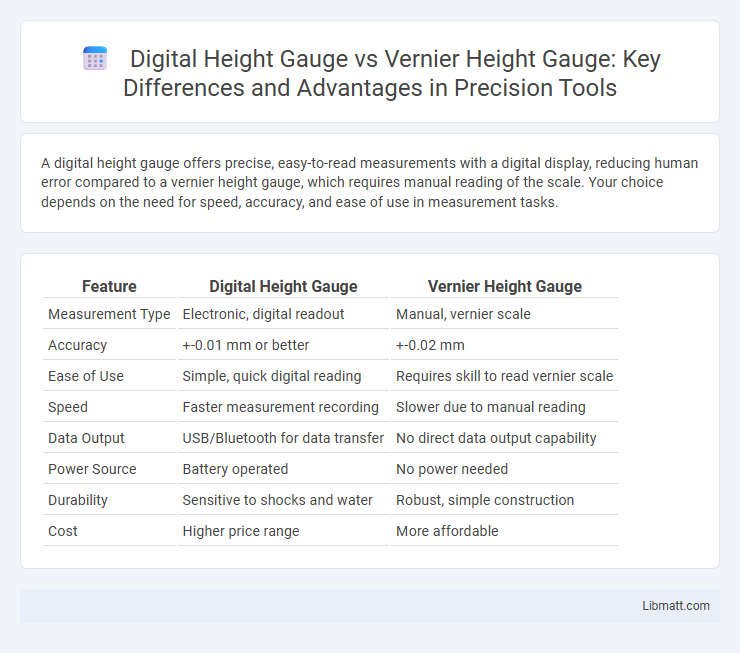A digital height gauge offers precise, easy-to-read measurements with a digital display, reducing human error compared to a vernier height gauge, which requires manual reading of the scale. Your choice depends on the need for speed, accuracy, and ease of use in measurement tasks.
Table of Comparison
| Feature | Digital Height Gauge | Vernier Height Gauge |
|---|---|---|
| Measurement Type | Electronic, digital readout | Manual, vernier scale |
| Accuracy | +-0.01 mm or better | +-0.02 mm |
| Ease of Use | Simple, quick digital reading | Requires skill to read vernier scale |
| Speed | Faster measurement recording | Slower due to manual reading |
| Data Output | USB/Bluetooth for data transfer | No direct data output capability |
| Power Source | Battery operated | No power needed |
| Durability | Sensitive to shocks and water | Robust, simple construction |
| Cost | Higher price range | More affordable |
Introduction to Height Gauges
Height gauges are precision measuring instruments used to determine vertical dimensions and mark items for accurate machining. Digital height gauges offer enhanced accuracy and readability with electronic measurement displays, reducing human error compared to the traditional vernier height gauges. Vernier height gauges rely on manual scale reading and provide reliable measurements but require more skill and time for interpretation.
Overview of Digital Height Gauge
Digital height gauges use electronic sensors to provide precise height measurements with a digital display, allowing for quick and accurate readings. They often feature measurement data output for easy integration with computers or data management systems, improving efficiency in quality control processes. Compared to vernier height gauges, digital models reduce human error and enhance repeatability in industrial and laboratory applications.
Overview of Vernier Height Gauge
The Vernier height gauge is a precision measurement tool used to determine vertical distances with high accuracy, often featuring a graduated scale and a sliding vernier for fine measurement readings. It is widely used in manufacturing and engineering for marking out workpieces and verifying dimensions. Unlike digital height gauges, which provide direct digital readouts, vernier height gauges require manual reading, making operator skill crucial for precise measurement.
Key Differences Between Digital and Vernier Height Gauges
Digital height gauges provide precise, easily readable measurements through an electronic display, reducing human error compared to vernier height gauges that require manual interpretation of scale readings. Digital models often feature data output options for integration with computer systems, enhancing efficiency in quality control processes, whereas vernier gauges rely solely on visual readings without digital connectivity. The digital variant typically offers faster measurement acquisition and improved accuracy, especially in industrial applications demanding high repeatability.
Accuracy and Precision Comparison
Digital height gauges provide superior accuracy and precision compared to vernier height gauges, often measuring within 0.01 mm or better, while vernier gauges typically offer accuracy around 0.02 mm. The digital display minimizes human reading errors, ensuring consistent and repeatable measurements for your critical applications. Precision in digital models is enhanced by advanced electronic sensors, making them ideal for tasks requiring meticulous detail and efficiency.
Ease of Use and User Experience
Digital height gauges offer intuitive operation with clear LCD displays and easy-to-read measurements, significantly reducing user errors compared to traditional vernier height gauges. The digital interface enables quick zero setting and data hold functions, enhancing measurement efficiency and repeatability for users in manufacturing and quality control. Vernier height gauges require visual decoding of scales and manual reading, which can be time-consuming and prone to inconsistencies, impacting overall user experience and accuracy.
Applications and Industry Suitability
Digital height gauges excel in precision measurement and are widely used in advanced manufacturing, automotive, aerospace, and quality control sectors demanding high accuracy and fast data readouts. Vernier height gauges remain popular in educational settings, basic workshops, and industries where cost efficiency and durability outweigh the need for digital integration. Both tools are essential for dimensional inspection but suit different operational environments based on technological requirements and budget constraints.
Maintenance and Durability
Digital height gauges require regular battery checks and calibration to maintain accuracy, while vernier height gauges demand careful cleaning and protection from moisture to prevent rust and wear. Digital models often feature durable stainless steel construction and shock-resistant components, enhancing longevity, whereas vernier gauges rely on their mechanical simplicity for long-term reliability with minimal maintenance. Your choice depends on whether you prioritize ease of maintenance with digital accuracy or the robust durability of a traditional vernier height gauge.
Cost Analysis and Affordability
Digital height gauges generally have a higher upfront cost compared to vernier height gauges due to advanced electronics and digital displays, but they offer faster readings and greater precision, which can reduce labor costs over time. Vernier height gauges are more affordable initially, making them suitable for budget-conscious users or basic measurement tasks, although they require more time and skill to read accurately. Considering long-term productivity and accuracy, digital height gauges provide better value despite the higher initial investment, whereas vernier gauges serve as a cost-effective option for simple, less frequent measurements.
Choosing the Right Height Gauge for Your Needs
Digital height gauges offer precise, easy-to-read measurements with enhanced functionality such as data storage and error reduction, making them ideal for high-accuracy industrial applications. Vernier height gauges provide reliable, budget-friendly performance without the need for batteries, suited for basic measuring tasks and environments where simplicity and durability are priorities. Selecting the right height gauge depends on accuracy requirements, ease of use, and the specific demands of your measuring tasks.
Digital height gauge vs vernier height gauge Infographic

 libmatt.com
libmatt.com